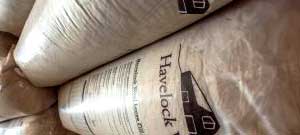As construction experts, we notice when  new home construction is going up in our region of Northern Virginia and Washington, D.C. And one thing we’ve been noticing is the frequent use of a new exterior sheathing product called Zip System™. ZIP System is easily identified by its green colored panels that are attached and sealed with black ZIP tape on all the exterior seams of the home.
new home construction is going up in our region of Northern Virginia and Washington, D.C. And one thing we’ve been noticing is the frequent use of a new exterior sheathing product called Zip System™. ZIP System is easily identified by its green colored panels that are attached and sealed with black ZIP tape on all the exterior seams of the home.
ZIP System has been gaining ground in the homebuilding market due to an aggressive marketing program, and because it is growing in popularity, homeowners can mistakenly think that it is a good product for streamlining weatherization and creating an air- and water-resistant barrier.
We’re here to tell you that are dangers to using this product.
Dangers of ZIP System
Faulty Moisture Protection
One reason to add a building wrap is to prevent water from building up behind the exterior wall. These water resistant barriers (WRBs) are designed to let water vapor pass through so moisture can be released to the outside, while prevent bulk water from entering, an essential process to release moisture that could potentially build up inside the wall. Each brand of building wrap is provided with a “perm rating,” and the higher the perm rating number, the better it allows vapor to pass through. Most building wraps advertise a perm rating in the 20s; ZIP System’s perm rating falls between 12 and 16.
Watch this YouTube video demonstration.
Faulty Drainage
As water vapor builds up, it creates droplets, and those water droplets need a way to escape. This is called the “drainage plane.” To keep water from entering a building, it needs to be directed away from the building; any gaps or holes will allow water to enter. A conventional house wrap is designed in overlapping layers to direct water away. With the ZIP System sheathing, the water-resistance relies on the sealing tape adhesive that seals the joints. The tape is guaranteed for only 30 years and relies on the strength and longevity of the adhesive. If it fails, water can penetrate.
Faulty Air Protection
In order for water vapor to escape, there must be a certain level of air flow in the building wrap. A lower perm rating number means a tighter seal. Compare a building wrap to a food-saving plastic wrap where a tight seal prevents air and moisture from getting to the protected food. A building wrap acts in the same manner, with a lower perm number acting as a non-permeable seal. Without proper air flow, moisture can build up behind the home’s exterior siding, and supporting structures cannot dry out, creating mold and deterioration problems.
Faulty Durability
As home construction has evolved throughout the years, we have seen sheathing methods change from boards, to plywood, to oriented strand board (OSB). Huber Engineered Woods, the manufacturer of the ZIP System roof and wall sheathing, is now offering water-resistant, treated OSB in its ZIP-WALL system designed to replace the vapor-permeable, water-resistant house wrap barrier
The ZIP System product is about the same thickness as plywood and when subjected to a buildup of moisture, can deteriorate at a much quicker rate than plywood. It is not recommended for use as a durable sheet panel product.
Faulty Cost Savings
While ZIP System may advertise cost savings due to its alleged speed of installation, it fails to take into account the additional costs of purchasing the panels and tape, which can raise the cost higher than a traditional house wrap system. OSB’s longevity is also up for questioning; it can last perhaps to 60 years, while plywood can serve for more than 100 years.
Potential Warranty Non-Coverage
Keep in mind that some roofing materials manufacturers will offer no warranty if their product is installed over OSB due to the fact that the material does not offer the same nail-holding stability as plywood.
What We Recommend Instead
475 Smart Enclosure System
There is a house sheathing product we do recommend: the 475 Smart Enclosure System, one that uses more natural and less toxic materials, working in harmony with nature. Benefits include:
- Higher wood content and lower plastic content (less toxicity)
- Sheathingless framing
- 100+ years durability
- Smart vapor control and airtightness for energy efficiency, durability and comfort
- Integration into whole building design for Passive House, Net Zero and Carbon Negative building performance
- Can be applied to any wall system
Sheep’s Wool Insulation
Havelock Wool, in partnership with 475 High Performance Building Supply, has created the “Smart Wall,” that includes the Havelock Wool’s sheep’s wool insulation, Pro Clima membranes and Gutex insulation board. It was designed to improve indoor air quality while protecting our planet by using non-toxic materials while creating an airtight, energy-efficient and long-lasting building envelope. Being biodegradable, sustainable and recyclable, natural wool insulation is highly effective for acoustic and thermal insulation purposes and its ability to absorb and release moisture.
When it Comes to Verifying Good Building Practices, Trust Först Consulting Group
At Först Consulting Group, we make it our mission to ensure that homeowners in Northern Virginia and Washington D.C. have healthy and sound environments in which to live and raise their families. We are proud to offer homeowner advocacy services to help protect them from fraudulent contractors and products. To learn more about all the services Först Consulting Group offers, visit our website or contact us today.




